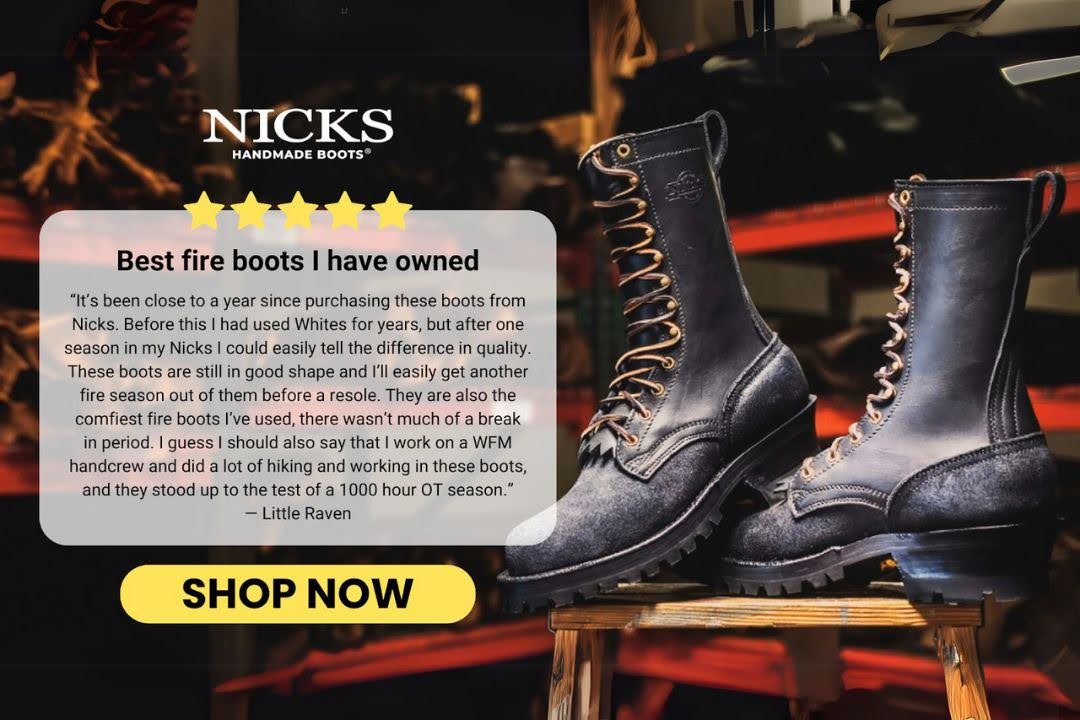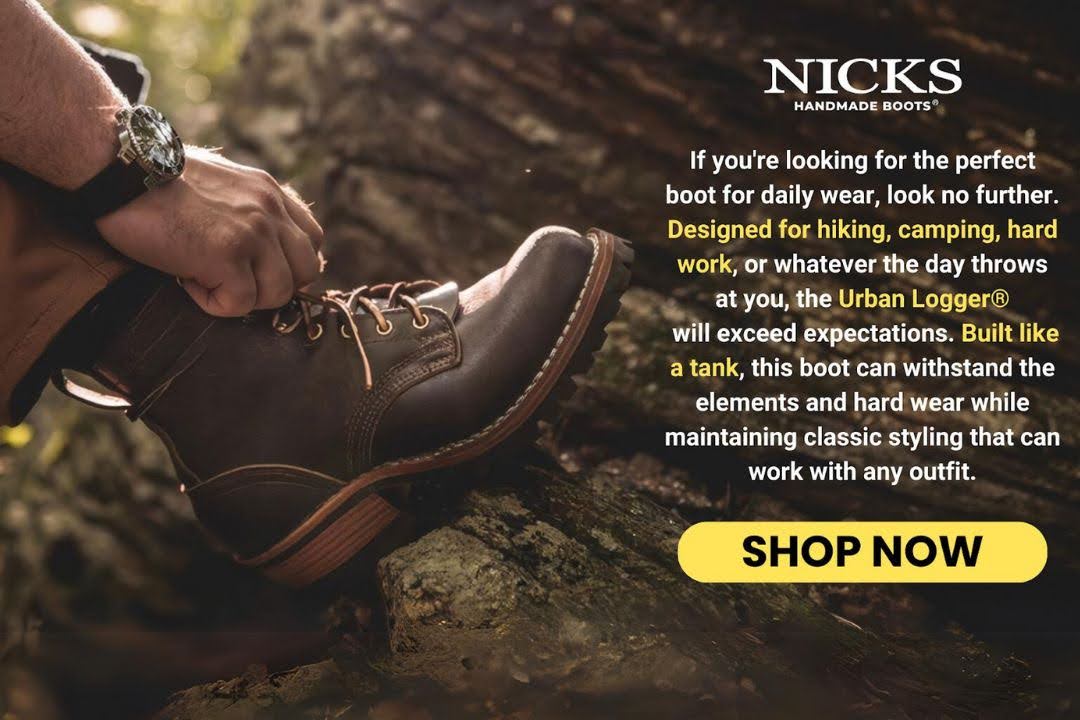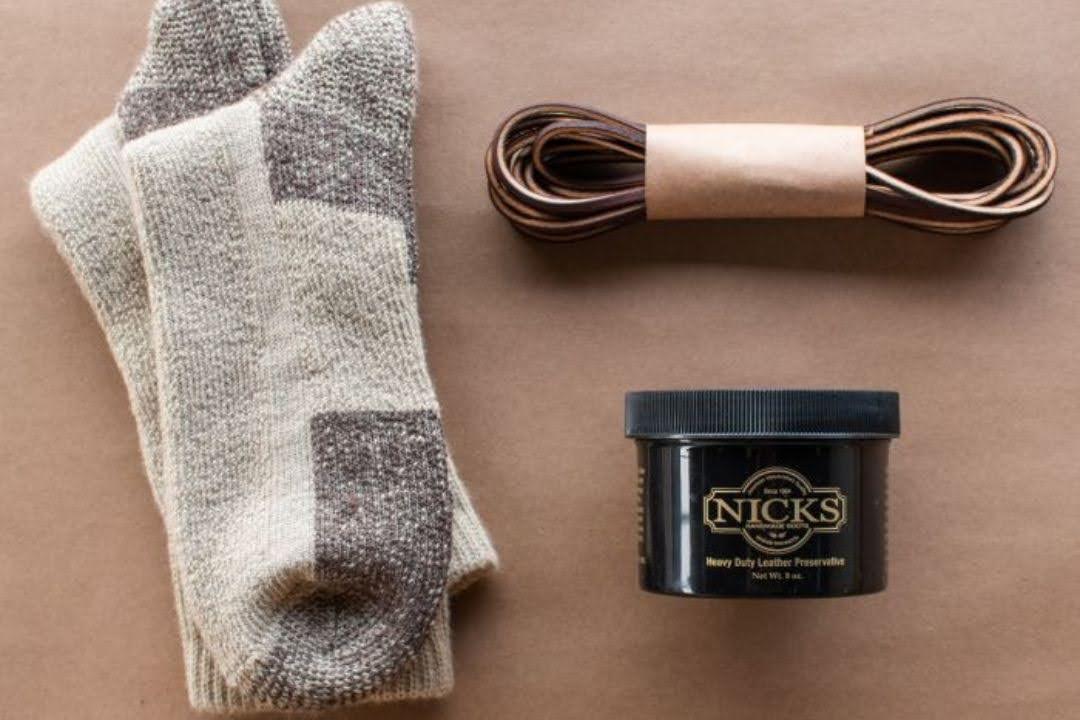Key Takeaways:
- Material Choice: Quality socks are made from materials like merino wool and synthetic blends that offer durability, moisture management, and comfort.
- Protective Features: Good work socks provide necessary cushioning and arch support, reducing fatigue and preventing foot injuries.
- Adaptability: The best work socks are versatile enough to handle various climates and work conditions, ensuring comfort and protection year-round.
At Nicks Boots, we take pride in manufacturing boots that represent a dedication to quality and longevity. With our extensive experience, we recognize that the effectiveness of a great pair of boots is complemented by the quality of the socks worn with them.
Choosing the right work socks is as crucial as selecting the perfect pair of boots, especially if you spend long hours on your feet. The best work socks not only provide comfort and support, but also offer moisture-wicking capabilities, temperature control, and durability to withstand daily wear and tear.
In this piece, we will guide you in choosing the best work socks that enhance comfort, manage moisture, and last long for both professional and leisure use. We'll explain the importance of selecting the right socks, discuss the essential attributes of top-quality work socks, compare different types, and offer our top picks to ensure your feet receive the care they deserve.

Why The Right Socks Matter
Protection Against Blisters And Injuries
Quality socks act as a cushion between your foot and the boot, significantly reducing the risk of friction that can lead to blisters and other discomforts. The right materials, such as densely woven fibers, provide a smooth interface that helps prevent chafing and skin irritation. This protection is especially crucial in demanding work environments where you move a lot, preventing minor injuries that could become bothersome over time. Ensuring your socks have the right fit and coverage also contributes to better protective qualities.
Moisture Control And Temperature Regulation
Effective moisture control is key to keeping feet dry and comfortable, preventing fungal infections and skin problems. Socks with advanced synthetic fibers or specialized wool blends excel in wicking away sweat, an essential feature for maintaining foot hygiene. Additionally, these materials are adept at temperature regulation, adapting to external conditions to keep your feet at an optimal temperature. This dual functionality makes them ideal for both hot and cold climates, ensuring year-round comfort.
Enhanced Comfort And Support
Socks designed for work boots often include targeted padding in key areas like the heels and toes, which absorbs impact and reduces strain. The cushioning also helps distribute pressure more evenly across the foot, preventing sore spots and fatigue during long hours of wear. High-quality socks often feature arch support, which can be crucial for maintaining good foot posture and comfort throughout the day. This support is essential for workers who need to stay mobile and pain-free, no matter their environment.
Enhance your workday comfort with the best work socks from Nicks Boots. Our carefully selected range offers superior cushioning, moisture control, and durability to keep your feet comfortable all day long. Shop now and feel the difference quality socks can make in your daily routine!
Key Features Of The Best Work Socks
Material Matters
The choice of material is crucial when selecting work socks. Natural fibers like wool are renowned for their breathability and moisture-wicking properties, while synthetic blends such as polyester and nylon offer durability and quick-drying capabilities. A combination of these materials often provides the best balance, ensuring socks are comfortable, durable, and easy to maintain. This blend also helps retain the sock's shape and effectiveness over numerous washes and wears.
Right Cushioning
Proper cushioning in work socks is vital for comfort and protection. Socks with enhanced padding at the footbed, heel, and toe areas offer better shock absorption, crucial for those who spend long hours on their feet. This feature not only increases comfort but also reduces the impact on the feet during activities that involve heavy lifting or extensive walking, protecting against fatigue and injury.
Arch Support
Good arch support in a sock is more than just comfort—it's about maintaining proper foot alignment and reducing strain on the foot muscles throughout the day. Socks with structured arch support help distribute weight evenly, which can prevent the development of foot pain and conditions like plantar fasciitis. This feature is particularly important for workers who require stability and support to perform their tasks efficiently.
Breathability And Temperature Control
A key feature of the best work socks is their ability to control temperature and allow the feet to breathe. Ventilation zones or mesh areas in socks enhance air circulation, keeping feet cooler in hot conditions and warm in cold environments. This adaptability makes the socks suitable for various working conditions and climates, ensuring all-day comfort.
Types Of Work Socks
- Cotton Socks - Cotton socks are popular for their softness and comfort. They are ideal for dry, moderate climates as cotton is highly breathable and gentle on the skin. However, cotton can absorb moisture and take longer to dry, which might not be suitable for highly sweaty feet or very wet conditions. These socks are best for those who prefer natural fibers and need less intensive moisture management.
- Wool Socks - Wool, particularly merino wool, is a superior choice for work socks due to its natural ability to manage moisture and regulate temperature. Wool socks are excellent for both cold and warm conditions, as they keep feet warm in the winter and cool in the summer. They are also naturally antimicrobial, which helps prevent odors. This makes them ideal for long shifts and tough conditions where comfort and odor control are priorities.
- Synthetic Socks - Socks made from synthetic materials like polyester, nylon, and spandex are designed for durability and performance. They dry quickly, provide excellent moisture-wicking properties, and maintain their shape and snug fit even after prolonged use. Synthetic socks are particularly beneficial for extremely wet or sweaty conditions and are favored for their ability to withstand rigorous activities without losing performance.
- Blended Socks - Blended socks combine the best qualities of different materials, such as cotton, wool, and synthetic fibers, to achieve optimal comfort, durability, and functionality. These blends are engineered to provide targeted cushioning, enhanced breathability, and superior moisture-wicking capabilities. Blended socks are versatile and suitable for a wide range of activities and weather conditions, making them a popular choice among workers who need reliable all-round performance.
How To Choose The Right Socks For Your Work Boots
Consider Your Work Environment
The work environment is a primary factor in choosing the right socks. If you're working in cold, wet conditions, socks with high thermal qualities and moisture-wicking properties are essential. For those in a high-heat environment, breathable and lighter socks can help keep feet cool and reduce sweat buildup. Consider if you need waterproof capabilities or additional odor control based on your exposure to elements and activity level. Each environmental condition demands specific sock features to maintain comfort and foot health throughout the workday.
Assess The Material Based On Needs
Material choice directly impacts the comfort and functionality of your socks. Wool is excellent for insulation and moisture management, making it ideal for varied climates, whereas cotton may be favored for its softness but might not perform well in damp conditions. Synthetics, such as polyester and nylon, are strong and fast-drying, suitable for intensive use and frequent washing. Blends of materials often offer a balanced solution, providing durability, comfort, and moisture management. Always choose a material that aligns with your daily demands to ensure maximum comfort and sock performance.
Check For Necessary Features
When selecting work socks, key features can significantly enhance your comfort and protection. Look for padded zones in socks if you're engaged in heavy labor to cushion impacts and reduce stress on your feet. Arch support is crucial for distributing pressure evenly and providing stability, which is beneficial during long standing hours. Moisture-wicking properties are essential for keeping feet dry and preventing fungal infections, particularly in warm or active conditions. Additionally, consider seamless toes to avoid irritation and ensure that the sock fits comfortably within your boot without bunching.
Fit And Length
The right fit is crucial in preventing issues like blisters and discomfort. Socks should fit snugly without constricting blood flow; this helps in maintaining proper circulation and preventing swelling. The length of the sock should be compatible with your boot to protect against chafing—crew or knee-high socks are necessary for taller boots to provide adequate coverage. Ensure the sock’s top doesn’t slip down into the boot, as this can cause bunching and discomfort. Lastly, regularly replace your socks as they lose elasticity and cushioning, to maintain optimal fit and functionality.
Top Recommendation For Work Socks
Nicks Handmade Boots Boot Socks
Nicks Handmade Boots Boot Socks are crafted to complement the rugged durability of Nicks Boots perfectly. These socks are designed with a focus on high wearability and protection in any work condition. Featuring a blend of premium materials, they offer excellent moisture management, superior cushioning, and high breathability. Ideal for those who value craftsmanship and the assurance of a sock that matches the quality of their boots.
Final Thoughts
Choosing the right work socks is essential for anyone who spends long hours on their feet, as it can significantly impact comfort and foot health. High-quality socks provide crucial benefits like moisture control, blister protection, and fatigue reduction, enhancing the effectiveness of sturdy work boots. By focusing on key features such as material quality, cushioning, and support, workers can ensure their socks meet the physical demands of their jobs while catering to individual comfort preferences and health requirements, making them an integral part of daily work attire.

Read also:
Frequently Asked Questions About Best Work Socks
What are the signs of a high-quality work sock?
High-quality work socks are made from durable materials that can handle frequent washing and wearing without losing their shape. They should also offer features like moisture-wicking and adequate cushioning for comfort and protection.
How often should I replace my work socks?
Work socks should be replaced when they begin to show signs of wear such as holes, thinning material, or loss of elasticity. Generally, this occurs every 6 to 12 months with regular use.
Can the right work socks prevent foot odor?
Yes, selecting socks with antibacterial or antimicrobial properties, typically found in materials like merino wool or certain synthetics, helps control bacteria growth and prevent odor.
What is the best material for work socks in hot climates?
For hot climates, choose socks made from lightweight, breathable materials that have moisture-wicking properties, such as synthetic blends or thin merino wool, to keep the feet dry and cool.
Are there work socks suitable for sensitive skin?
Socks made from natural fibers like bamboo or fine merino wool are hypoallergenic and gentle on the skin, making them a great choice for those with sensitive skin.
How does arch support in a sock benefit me at work?
Arch support in socks helps distribute your weight evenly, reducing foot fatigue and preventing conditions like plantar fasciitis, which is crucial for workers who stand for long periods.
What features should I look for in socks for winter work conditions?
Look for socks with good insulation properties, such as thicker wool blends, for winter conditions. These socks should also manage moisture well to keep your feet warm and dry.
Can the wrong socks affect the performance of my work boots?
Improper socks can cause your feet to slip inside the boots, leading to blisters and discomfort, thus affecting the performance and comfort of your work boots.
What’s the advantage of blended material socks over pure materials?
Blended materials combine the best properties of various fibers, offering enhanced durability, flexibility, and moisture management, ideal for diverse working environments.
How do I choose the right length of work sock for different styles of boots?
The right sock length depends on your boots; choose crew-length or knee-high socks for taller boots to prevent chafing, and ankle-length socks for shorter boots to ensure comfort and adequate coverage.





































